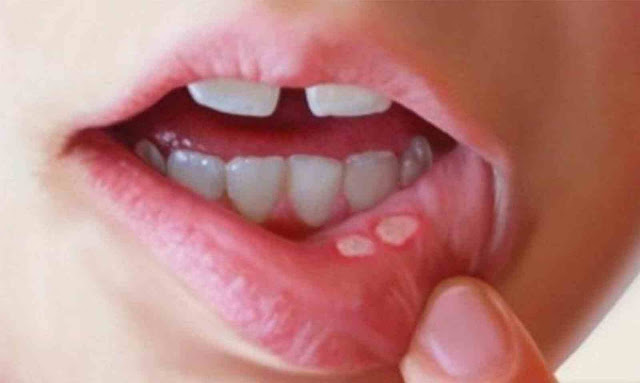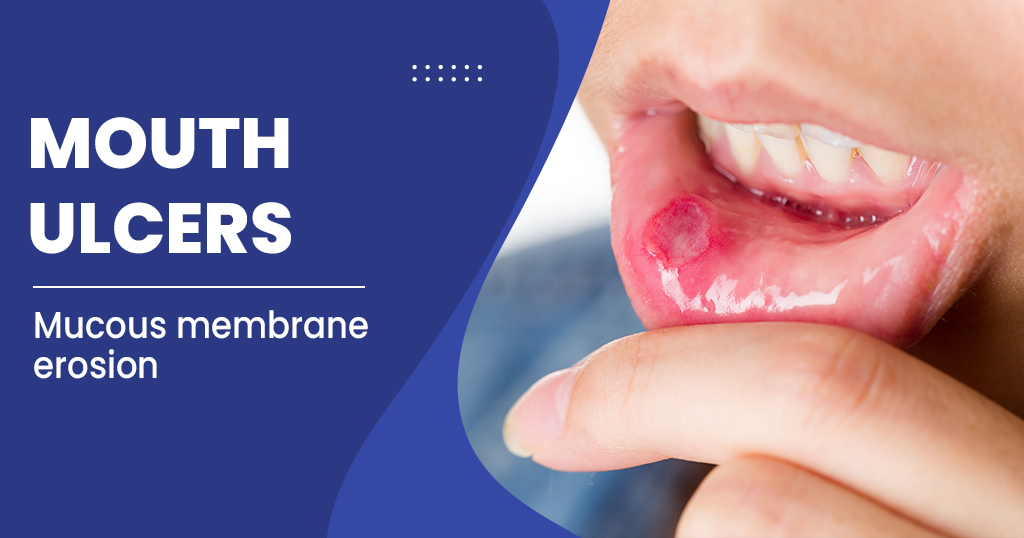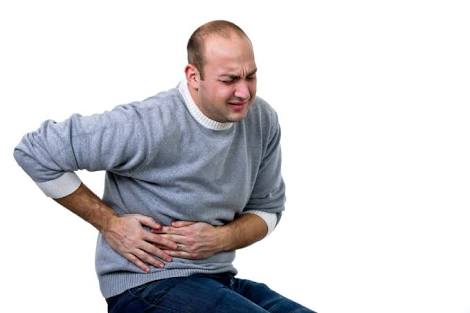Mouth Ulcers/ Oral Stomatitis
Mouth Ulcers/ Oral Stomatitis
One or more painful sores on inner lips, gums, tongue, roof of the mouth or throat that may interfere with eating, such as a canker sore. A mouth ulcer (aphtha) is an ulcer that occurs on the mucous membrane of the oral cavity. Oral ulceration is a common reason for people to seek medical or dental advice. A breach of the oral mucosa probably affects most people at various times during life.
Introduction
An ulcer from Latin ulcus, "ulcer, sore" is a break in the skin or mucous membrane with loss of surface tissue and the disintegration and necrosis of epithelial tissue. A mucosal ulcer is an ulcer which specifically occurs on a mucous membrane.
An ulcer is a tissue defect which has penetrated the epithelial-connective tissue border, with its base at a deep level in the submucosa, or even within muscle or periosteum. An ulcer is a deeper breach of epithelium compared to an erosion or excoriation, and involves damage to both epithelium and lamina propria.
An erosion is a superficial breach of the epithelium, with little damage to the underlying lamina propria. A mucosal erosion is an erosion which specifically occurs on a mucous membrane. Only the superficial epithelial cells of the epidermis or of the mucosa are lost, and the lesion can reach the depth of the basement membrane. Erosions heal without scar formation.
Excoriation is a term sometimes used to describe a breach of the epithelium which is deeper than an erosion but shallower than an ulcer. This type of lesion is tangential to the rete pegs and shows punctiform (small pinhead spots) bleeding, caused by exposed capillary loops. Rete pegs are finger-like structures that are formed during the development and wound healing process of the skin and oral mucosa, and they provide better mechanical resistance and nutritional supply between the epithelium and dermis
Glossitis
Catarrhal Stomatitis: inflammation of a mucous membrane in humans, chronically affecting the human nose and air passages
(i.e. After Drugs (Antibiotics) Stomatitis (Sore Mouth)
Why are mouth ulcers so painful?
Why do they hurt so much? A canker sore is essentially an injury to the inside of your mouth. Unfortunately, the inside of your mouth is full of digestive enzymes and acids that eat into the sore, which is what causes the pain.
Causes
Ulcers and erosions can be the result of a spectrum of conditions including: Aphthous stomatitis and local trauma are very common causes of oral ulceration; the many other possible causes are all rare in comparison.
| Agent | Example(s) |
| Viral | Herpes, chickenpox, hand, foot and mouth disease, herpangina, herpetic stomatitis, human immunodeficiency virus, infectious mononucleosis. |
| Bacterial | acute necrotizing ulcerative gingivitis, gangrenous stomatitis, syphilis, tuberculosis |
| Fungal | Candida, blastomycosis, cryptoccissosis, histoplasmosis, Para coccidioidomycosis |
| Parasitic | leishmaniasis |
- Nutritional deficiencies : (e.g., vitamin B12, Folic acid, Iron deficiencies).
- Chemicals such as SLS (a common ingredient in many toothpastes) have been linked to mouth ulcers, and have been recognized by public health agencies such as the NHS as a risk factor.
- Injuries (e.g. biting of the lip, tongue, and cheek, hard foods can scrape the oral tissues, hot foods can cause burns)
- Emotional Stress: Possible triggers of aphthous ulcers include emotional stress. When the body is stressed, the immune symptom may trigger mouth sores
- Those causing auto-immune epithelial damage, damage because of an immune defect (e.g., HIV, leukemia )
- Hematological causes include deficiencies, neutropenia, hyper eosinophilic syndrome, leukemia, myelodysplastic syndromes, other white cell dyscrasias, and gammopathies..
- Gastrointestinal causes include celiac disease, Crohn's disease (orofacial celiac disease, Crohn's disease, (orofacial granulomatosis) and ulcerative colitis.
- Dermatological causes include chronic ulcerative stomatitis, erythema multiforme (Stevens-Johnson syndrome), angina bullosa haemorrhagica and lichen planus.
- Prolong use of steroids
- Aggressive tooth brushing
- History of recent fracture or hospitalization.
- Dehydration : Due to diarrhea or vomiting.
- Dryness of mouth : Antihistamines, Atropine,
- Recurrent ulcers before menstruation : Due to estrogen deficiency.
- Leukoplakia : Rule out malignancy by taking Biopsy of the Patch.
- Periodic fever
- Due to various factors (saliva, relative thinness of oral-mucosa, trauma from teeth, chewing, etc.), vesicles and bullae which form on the mucous membranes of the oral cavity tend to be fragile and quickly break down to leave ulcers.
- Traumatic ulceration : Most mouth ulcers that are not associated with recurrent aphthous stomatitis are caused by local trauma. The mucous membrane lining of the mouth is thinner than the skin, and easily damaged by mechanical, thermal (heat/cold), chemical, or electrical means, or by irradiation.
- Common causes of oral ulceration include rubbing on sharp edges of teeth, fillings, crowns, false teeth (dentures), or braces (orthodontic appliances), or accidental biting caused by a lack of awareness of painful stimuli in the mouth (e.g., following local anesthetic used during dental treatment, which the person becomes aware of as the anesthetic wears off). Eating hard foods can damage the lining of the mouth. Some people cause damage inside their mouths themselves, either through an absent minded habit or as a type of deliberate self harm factitious (ulceration). Examples include biting the cheek, tongue, or lips, or rubbing a fingernail, pen, or toothpick inside the mouth. Tearing (and subsequent ulceration) of the upper labial frenum may be a sign of child abuse (non-accidental injury).
- Iatrogenic ulceration can also occur during dental treatment, where incidental abrasions to the soft tissues of the mouth are common. Some dentists apply a protective layer of petroleum jelly to the lips before carrying out dental work to minimize this.
- Thermal and electrical burn : Thermal burns usually result from placing hot food or beverages in the mouth. This may occur in those who eat or drink before a local anesthetic has worn off. The normal painful sensation is absent and a burn may occur. Microwave ovens sometimes produce food that is cold externally and very hot internally, and this has led to a rise in the frequency of intra-oral thermal burns. Thermal food burns are usually on the palate or posterior buccal mucosa, and appear as zones of erythema and ulceration with necrotic epithelium peripherally. Electrical burns more commonly affect the oral commissure (corner of the mouth). The lesions are usually initially painless, charred and yellow with little bleeding. Swelling then develops and by the fourth day following the burn the area becomes necrotic and the epithelium sloughs off. Electrical burns in the mouth are usually caused by chewing on live electrical wiring (an act that is relatively common among young children). Saliva acts as a conducting medium and an electrical arc flows between the electrical source and the tissues, causing extreme heat and possible tissue destruction
- Chemical injury : Caustic chemicals may cause ulceration of the oral mucosa if they are of strong-enough concentration and in contact for a sufficient length of time. The holding of medication in the mouth instead of swallowing it occurs mostly in children, those under psychiatric care, or simply because of a lack of understanding. Holding an aspirin tablet next to a painful tooth in an attempt to relieve pulpitis (toothache) is common, and leads to epithelial necrosis. Chewable aspirin tablets should be swallowed, with the residue quickly cleared from the mouth. Other caustic medications include eugenol and chlorpromazine. Hydrogen peroxide, used to treat gum disease, is also capable of causing epithelial necrosis at concentrations of 1–3%. Silver nitrate, sometimes used for pain relief from aphthous ulceration, acts as a chemical cauterant and destroys nerve endings, but the mucosal damage is increased. Phenol is used during dental treatment as a cavity sterilizing agent and cauterizing material, and it is also present in some over-the-counter agents intended to treat aphthous ulcerations. Mucosal necrosis has been reported to occur with concentrations of 0.5%. Other materials used in endodontics are also caustic, which is part of the reason why use of a rubber dam is now recommended.
- Irradiation : As a result of radiotherapy to the mouth, radiation-induced stomatitis may develop, which can be associated with mucosal erosions and ulceration. If the salivary glands are irradiated, there may also be xerostomia (dry mouth), making the oral mucosa more vulnerable to frictional damage as the lubricating function of saliva is lost, and mucosal atrophy (thinning), which makes a breach of the epithelium more likely. Radiation to the bones of the jaws causes damage to osteocytes and impairs the blood supply. The affected hard tissues become hypo vascular (reduced number of blood vessels), hypocellular (reduced number of cells), and hypoxic (low levels of oxygen). Osteoradionecrosis is the term for when such an area of irradiated bone does not heal from this damage. This usually occurs in the mandible, and causes chronic pain and surface ulceration, sometimes resulting in non-healing bone being exposed through a soft tissue defect. Prevention of osteoradionecrosis is part of the reason why all teeth of questionable prognosis are removed before the start of a course of radiotherapy.
- Aphthous stomatitis : Possible triggers of aphthous ulcers include: Emotional stress. Minor injury to the inside of the mouth, for example from cuts, burns or bites while eating, dental work, hard brushing or ill-fitting dentures. Aphthous stomatitis (also termed recurrent aphthous stomatitis, RAS, and commonly called "canker sores") is a very common cause of oral ulceration. 10–25% of the general population have this non-contagious condition. Three types of aphthous stomatitis exists based on their appearance, namely minor, major and herpetiform major aphthous ulceration. Minor aphthous ulceration is the most common type, presenting with 1–6 small (2-4mm diameter), round/oval ulcers with a yellow-grey color and an erythematous (red) "halo". These ulcers heal with no permanent scarring in about 7–10 days. Ulcers recur at intervals of about 1–4 months. Major aphthous ulceration is less common than the minor type, but produces more severe lesions and symptoms. Major aphthous ulceration presents with larger (>1 cm diameter) ulcers that take much longer to heal (10–40 days) and may leave scarring. The minor and major subtypes of aphthous stomatitis usually produce lesions on the non-keratinized oral mucosa (i.e. the inside of the cheeks, lips, underneath the tongue and the floor of mouth), but less commonly major aphthous ulcers may occur in other parts of the mouth on keratinized mucosal surfaces. The least common type is herpetiform ulceration, so named because the condition resembles primary herpetic gingivostomatitis . Herpetiform ulcers begin as small blisters (vesicles) which break down into 2-3mm sized ulcers. Herpetiform ulcers appear in "crops" sometimes hundreds in number, which can coalesce to form larger areas of ulceration. This subtype may cause extreme pain, heals with scarring and may recur frequently. The exact cause of aphthous stomatitis is unknown, but there may be a genetic predisposition in some people.
- Other possible causes include hematinic deficiency (folate, vitamin B, iron), stopping smoking, stress, menstruation, trauma, food allergies or hypersensitivity to sodium lauryl sulphate (found in many brands of toothpaste). Aphthous stomatitis has no clinically detectable signs or symptoms outside the mouth, but the recurrent ulceration can cause much discomfort to those affected. Treatment is aimed at reducing the pain and swelling and speeding healing, and may involve systemic or topical steroid, analgesics (pain killers), antiseptics, anti-inflammatories or barrier pastes to protect the raw area(s).
- Allergy : An example of one common allergen is Balsam of Peru. If individuals allergic to this substance have oral exposure they may experience stomatitis. (inflammation, rash, or painful erosion of the lips, oropharyngeal mucosa, or angles of their mouth). Balsam of Peru is used in foods and drinks for flavoring, in perfumes and toiletries for fragrance, and in medicine and pharmaceutical items for healing properties
- Drug-induced : Antibiotics, Antitubercular drugs. Many drugs can cause mouth ulcers as a side effect. Common examples are alendronate (a bisphosphonate, commonly prescribed for osteoporosis), cytotoxic drugs (e.g. methotrexate, i.e. chemotherapy), non-steroid anti-inflammatory drugs,
- NSAIDs. Mefenamic acid, Diclofenac, Ibuprofen, Indomethacin, Ketoprofen, Ketorolac, Diflunisal, Piroxicam, Naproxen, Ketoprofen, Etodolac, Flurbiprofen, Meloxicam, Nabumetone, Oxaprozin, Sulindac, Tolmetin.
- Nicorandil (may be prescribed for angina) and propylthiouracil (e.g. used for hyperthyroidism). Some recreational drugs can cause ulceration, e.g. cocaine
- Malignancy: Rarely, a persistent, non-healing mouth ulcer may be a cancerous lesion. Malignancies in the mouth are usually carcinomas, Either the tumor arises in the mouth, or it may grow to involve the mouth, e.g. from the maxillary sinus, salivary glands, nasal cavity or peri-oral skin. The most common type of oral cancer is squamous cell carcinoma. The main risk factors are long-term smoking and alcohol consumption (particularly when combined) and betel use. Common sites of oral cancer are the lower lip, the floor of the mouth, and the sides, underside of the tongue and mandibular alveolar ridge, but it is possible to have a tumor anywhere in the mouth. Appearances vary greatly, but a typical malignant ulcer would be a persistent, expanding lesion that is totally red (erythroplasia) or speckled red and white (erythroleukoplakia). Malignant lesions also typically feel indurated (hardened) and attached to adjacent structures, with "rolled" margins or a punched out appearance and bleeds easily on gentle manipulation.




.jpeg)
.jpeg)




.jpeg)
%20(1).jpeg)









.jpeg)



.jpeg)



Comments
Post a Comment